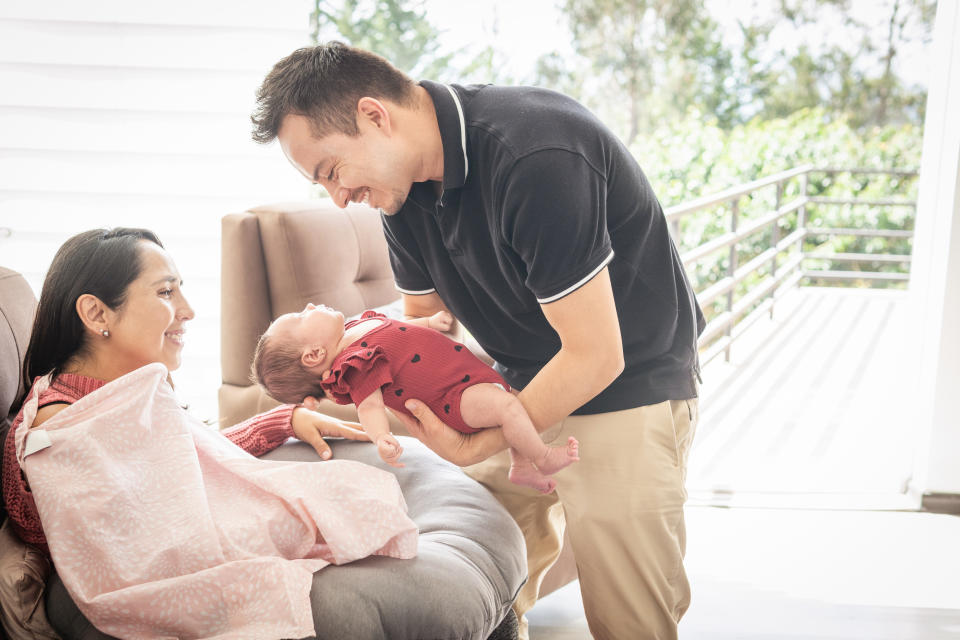Fathers' Involvement in Safe Sleep Practices for Babies Can Improve Infant Health Outcomes, New Research Finds

With Father’s Day around the corner, dads are in the spotlight in terms of their involvement in raising their children. And though fathers are more involved than ever from day one of their babies’ birth, especially in feeding and bedtime, there is more room for improvement in their education of the healthiest and safest practices, according to new research published in the journal Pediatrics. And that in turn can improve health outcomes for babies.
When it comes to safe sleep for babies, researchers at Northwestern University funded by the CDC polled 250 fathers in the state of Georgia and found that 99 percent of them had put their infant to sleep — so that’s a good start. The not-so-great news was that they weren’t all aware of the American Academy of Pediatrics’ guidelines of sleep safety for infants.
More from SheKnows
Here’s how those break down: Infants should be on their back to sleep at all times. 81 percent of fathers in the study reported that they complied with that, and most admitted that they received advice from a healthcare provider to do so.
Only about 32 percent of fathers said that they always placed the baby on approved sleep surface: one that is firm, flat, and covered only by a fitted sheet. And only 44 percent of fathers reported that they avoided the use of soft bedding such as comforters and other things such as stuffed animals or toys in the crib while the baby was asleep. Few fathers said that they routinely followed all three of those sleep guidelines, but perhaps this is because they were not properly educated by healthcare providers on this safety measures.
Click here to read the full article.
There was a breakdown in the study data by race: Black fathers who were surveyed were less likely to use the safe sleep practices for babies, including putting the baby on their back to sleep and not using soft bedding. Study participants who self-identified as non-Hispanic white and/or as college graduates were more likely to be aware of all three sleep practices — but those were the groups that were more likely to receive advice on safe sleep practices for babies, according to the study.
And it translates to infant health. According to the CDC, the rates of Sudden Infant Death Syndrome (SIDS), for which sleep safety practices are a preventive measure, are highest among Indigenous and Black infants.
All of these statistics are proof that public health officials and healthcare providers need to do more work to reach fathers in Black, Indigenous, and working class communities.

How else are fathers involved in infant health outcomes?
The Pediatrics study also asked fathers about breastfeeding, a feeding method that’s been supported by the American Academy of Pediatrics for infant immunity and development (however, not everyone is able to breastfeed, chestfeed, pump, or continue to do so for an extended period postpartum, so ‘fed is best’).
86 percent of fathers did report that their baby did begin breastfeeding, the majority being Hispanic or Latinx-identifying fathers or college graduates, but those numbers started to dwindle after the baby was 8 weeks or older. Fathers who said that they supported breastfeeding for their baby past those initial 8 weeks were more likely to have babies whose parents continued to breastfeed.
The very same communities who self-identified as Black or high school graduates and who were not receiving enough education on safe sleep for babies were not receiving adequate education on the health benefits of breastfeeding. Along with more attention from pediatricians, there can also be better lactation support in hospitals and thereafter, that includes fathers and how they can support infant feeding in whatever way is best for their family.
Best of SheKnows
11 Books You Need to Read If You're Going Through Perimenopause or Menopause
9 Cute, Useful Pieces of Insect-Repellent Clothing to Buy Now — Before Summer Bug Season
Sign up for SheKnows' Newsletter.
For the latest news, follow us on Facebook, Twitter, and Instagram.

